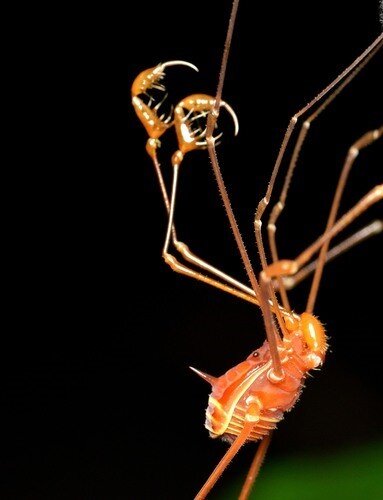This month, the guys set out to discover if daddy longlegs really are the most poisonous spider in the world, but, along the way, they uncover a fascinating array of arachnids and adaptations in the group known collectively as harvestmen. Join them for some mythbusting and a deep dive into the little-known order of arachnids called Opiliones.
This episode was recorded at JP Nicely Park in West Falls, NY on June 28, 2021.
Episode Notes
Steve referred to the American toad as Bufo americanus, and Bill agreed. But they were both wrong because its Latin name has been changed to Anaxyrus americanus.
At one point, Bill made a comment where he seemed to be saying that all reptiles have teeth. They do not. He wants to clarify that he was speaking specifically about snakes. What he should have said is “Most snakes have teeth, but not all snakes have fangs.”
Steve mentioned that he didn’t know much about Dick Walton, so we looked him up! Turns out Dick Walton is a naturalist and teacher living in Concord, MA. He considers himself a generalist but has focused on birds, butterflies, dragonflies, solitary wasps, and jumping spiders. He coauthored Peterson’s seminal Birding By Ear audio field guides, the go-to guide for budding birders in the pre-app era. Check out his work at http://www.rkwalton.com/ The guys have great respect for his work and hope that Mr. Walton was not offended by their joking around in this episode..
What is the origin of the name “daddy longlegs”? No one seems to know for sure, but some sources point to the book, Daddy-Long-Legs, a 1912 novel by the American writer Jean Webster. But the book, as far as we can tell, has nothing to do with arachnids. So, we’re still scratching our heads on that one.
Steve wondered if crane flies are dipterans – they are!
Also, during this episode, Steve had a couple questions about the mouth parts of dipterans (flies) and hemipterans (true bugs):
Do all dipterans have sucking mouth parts? Yes! “Flies have a mobile head, with a pair of large compound eyes, and mouthparts designed for piercing and sucking (mosquitoes, black flies and robber flies), or for lapping and sucking in the other groups. “ from Wikipedia
How are wheel bugs killing? The wheel bugs is a species of assassin bug and is a True Bug (Order Hemiptera). “Most hemipterans feed on plants, using their sucking and piercing mouthparts to extract plant sap…but some hemipterans such as assassin bugs are blood-suckers, and a few are predators” from Wikipedia
Steve wondered if mites were the largest group of invertebrates, but it turns out that arthropods. Ok, then, are mites the largest order of arthropods. Nope, that honor belongs to insects. Alright, maybe Steve meant to say that mites are the largest group of arachnids, but, still no, spiders are.
Do spider legs have chemical receptors? Spiders, in fact, do taste, and also smell, through special sensory organs on their legs, as well as on their pedipalps.
Steve was correct when he said that our five local species of ashes (black, white, green, blue, and pumpkin) are critically endangered.
Steve mentioned seeing a kissing bug covered in dust in his house, but a search did not turn up any records of this behavior in kissing bugs. Maybe Steve was referring to an insect commonly called the masked hunter (Reduvius personatus). Masked hunters are given this name because the immature masked hunter carries dust and debris on its body to camouflage itself.
What are the hairs in pitcher plants called? Trichomes
Useful Links
Gumleaf Boots, USA (free shipping for patrons)
Thank you to Always Wandering Art (Website and Etsy Shop) for providing the artwork for many of our previous episodes!
Support us on Patreon!
Check out the Field Guides merch at our Teespring store. It’s really a great deal: you get to pay us to turn your body into a billboard for the podcast!
Works Cited
Pinto-da-Rocha, Ricardo, Glauco Machado and Gonzalo Giribet. 2007. Harvestmen: The Biology of Opiliones. Cambridge, MA: Harvard University Press.
Shear, W.A. (2009) 'Harvestmen: Opiliones--which include daddy-long-legs--are as exotic as they are familiar', American Scientist, 97(6), 468+, available: https://link.gale.com/apps/doc/A229835627/AONE?u=nysl_oweb&sid=googleScholar&xid=680b9445 [accessed 25 Jun 2021].
Zobel-Thropp, P.A., Mullins, J., Kristensen, C., Kronmiller, B.A., David, C.L., Breci, L.A. and Binford, G.J., 2019. Not so dangerous after all? Venom composition and potency of the Pholcid (Daddy Long-Leg) spider Physocyclus mexicanus. Frontiers in ecology and evolution, 7, p.256.
Image Credit
Macro of a orange harvestman (Gagrellinae, likely Jussara sp.) found in the Atlantic forest (tropical rainforest) of Parque do Zizo, private reserve in São Paulo, Brazil..Date 2 May 2008, 12:59:46 Source Own work Author João P. Burini https://commons.wikimedia.org/wiki/File:Opiliones,_Sclerosomatidae,_Gagrellinae_-_Parque_do_Zizo_S%C3%A3o_Paulo.jpg


